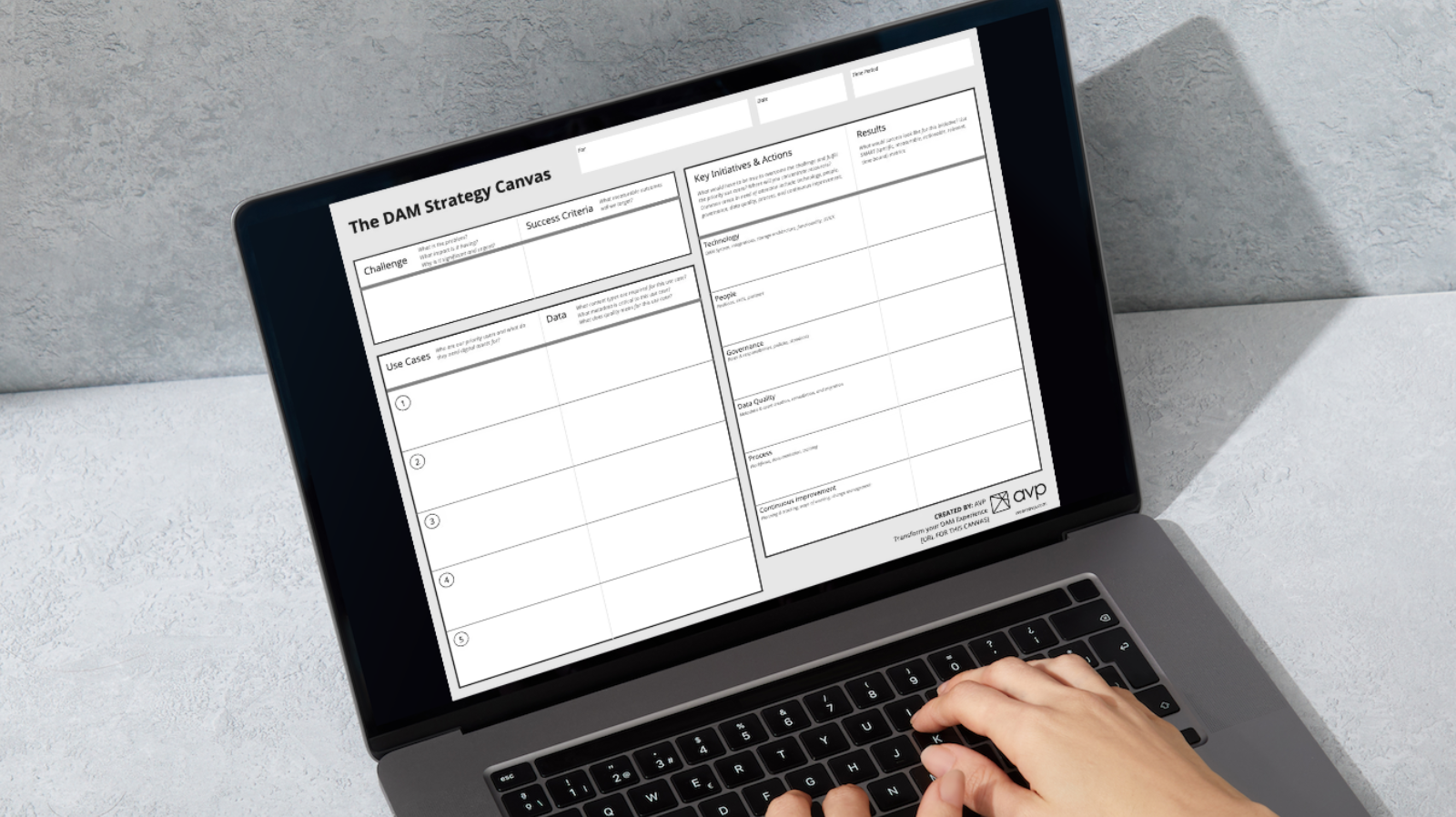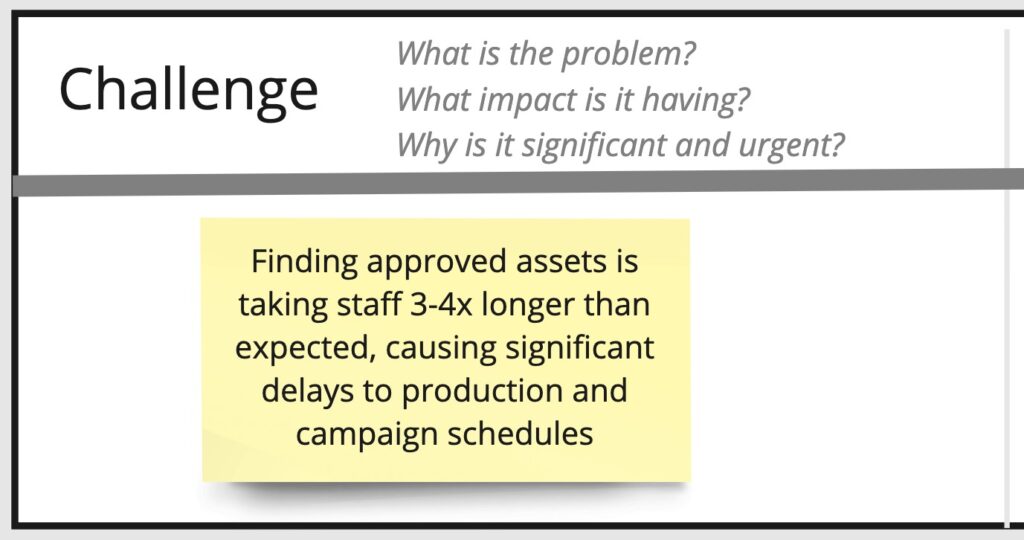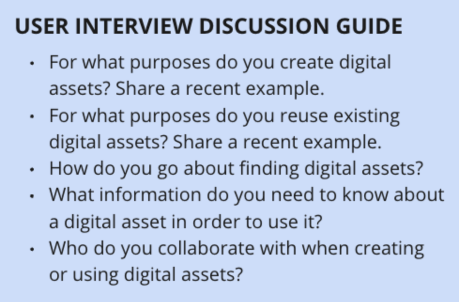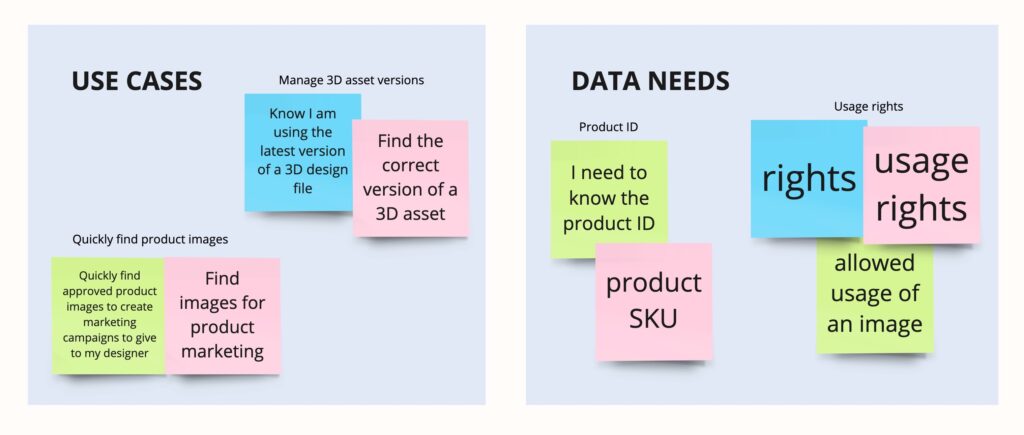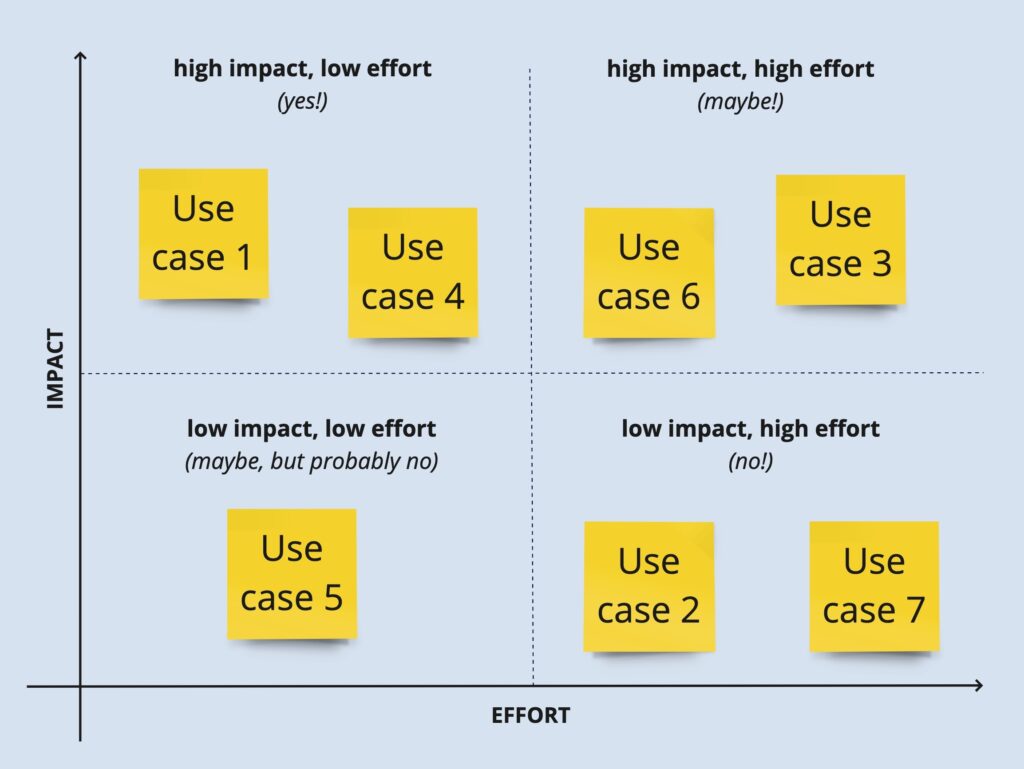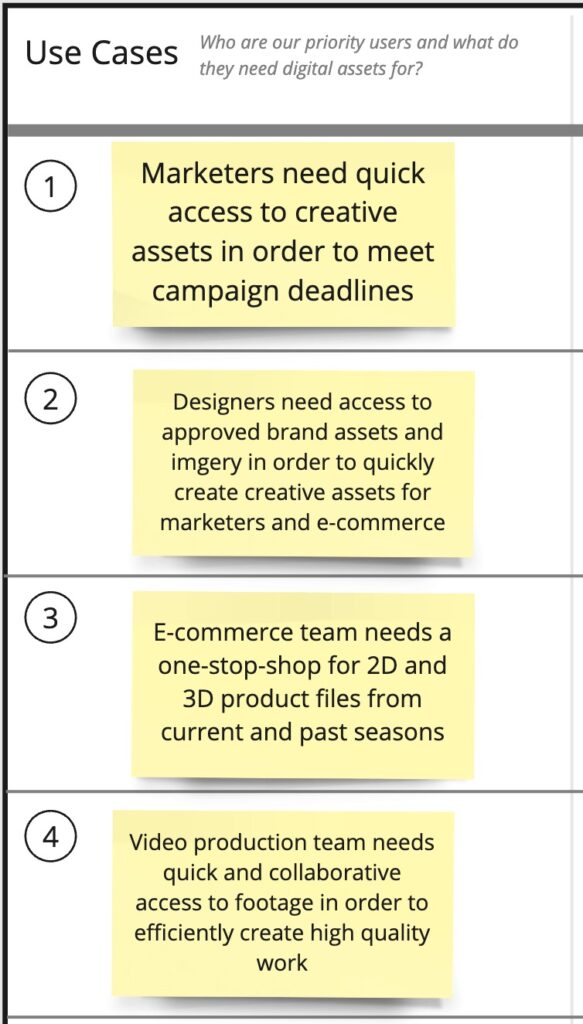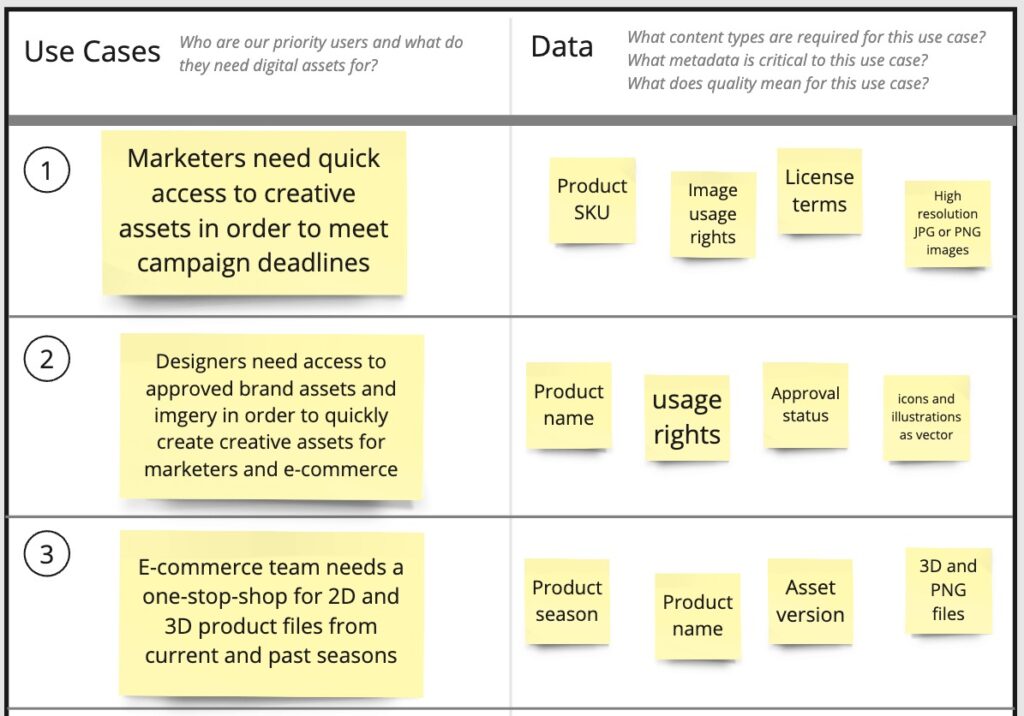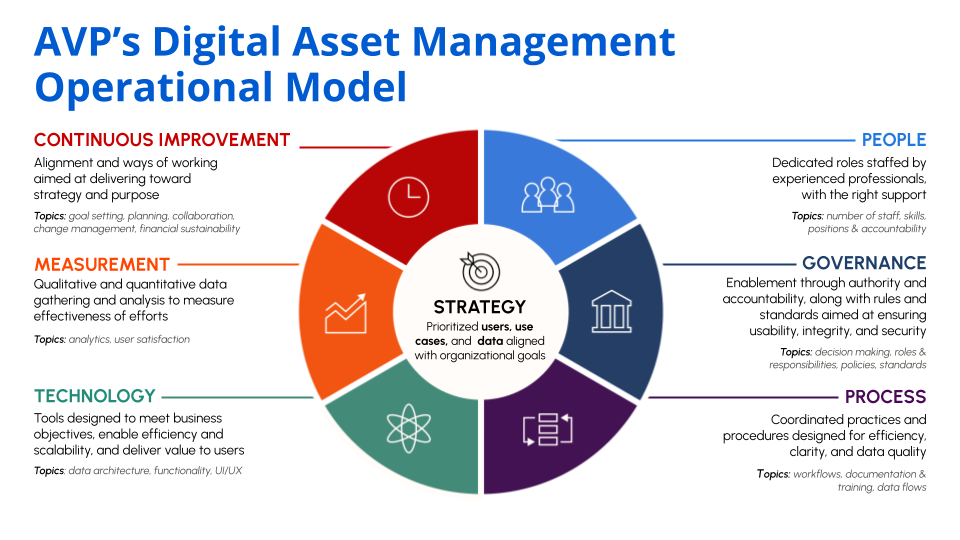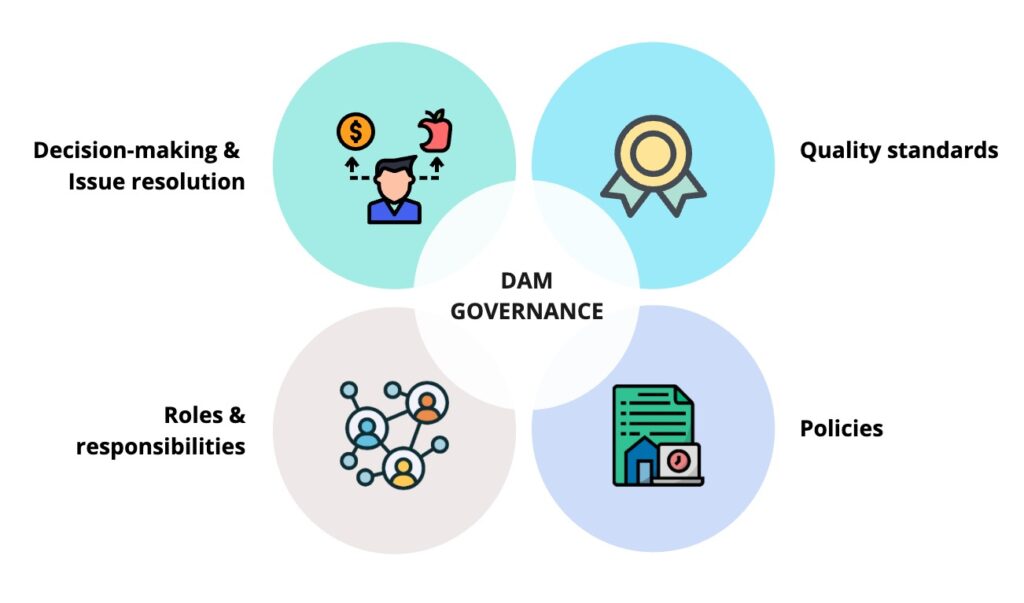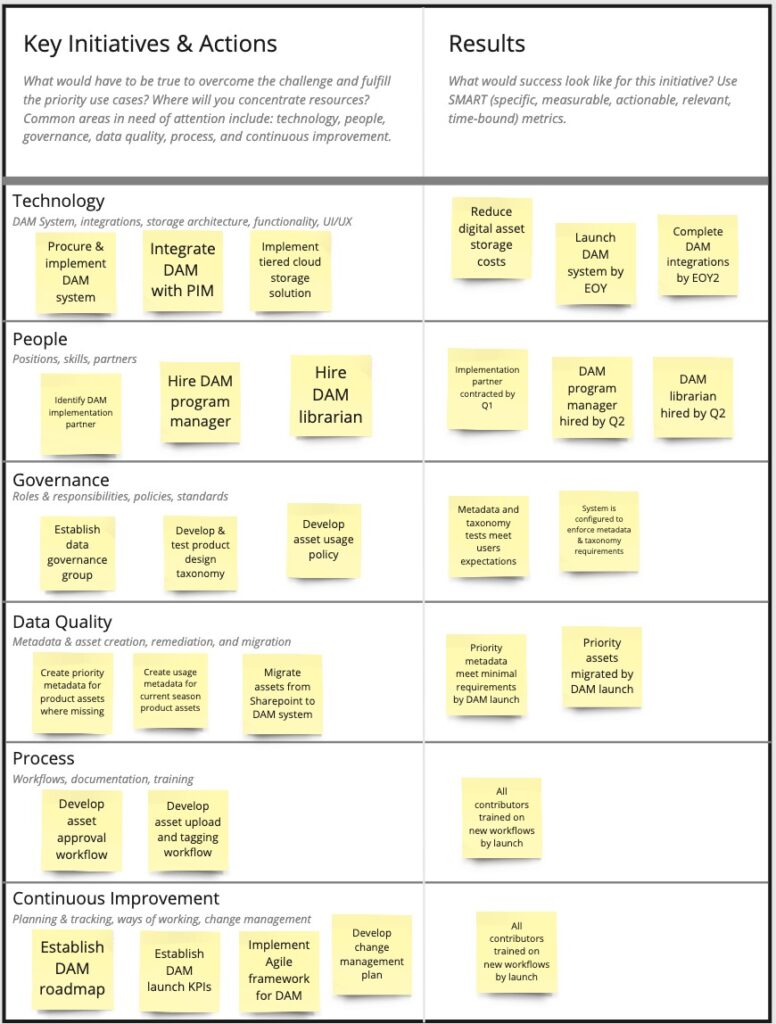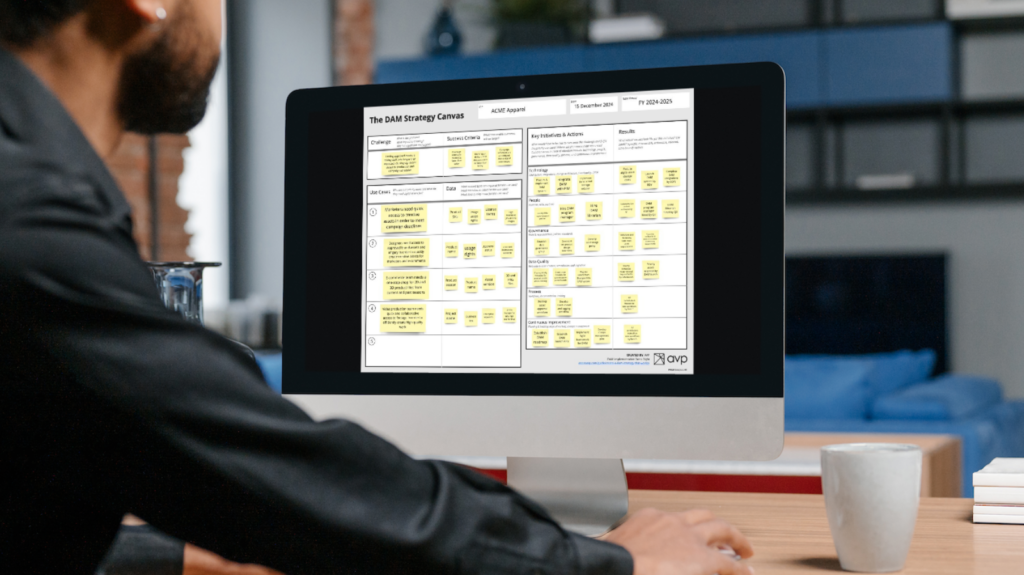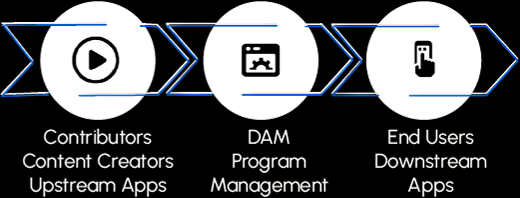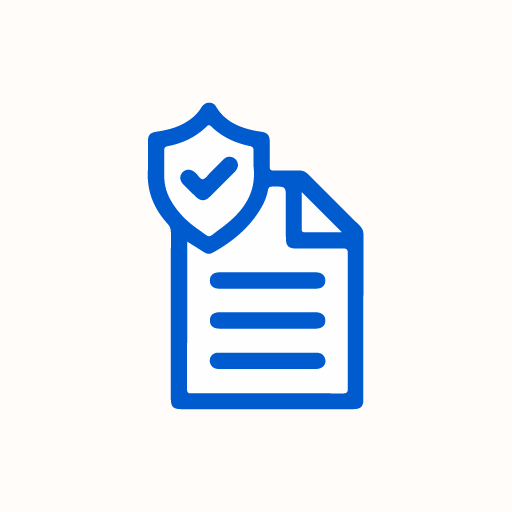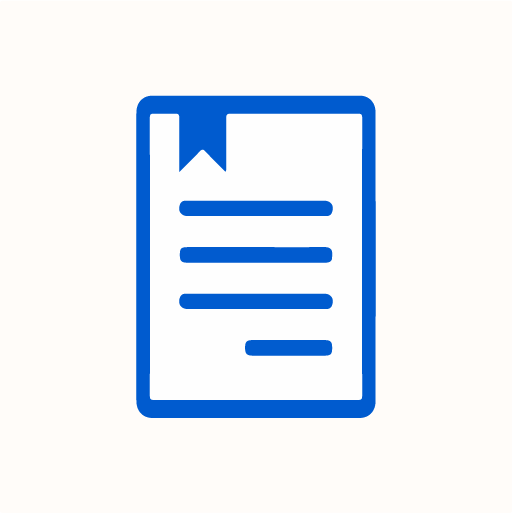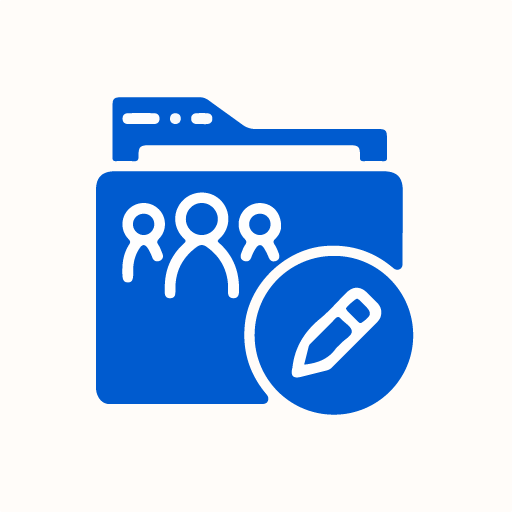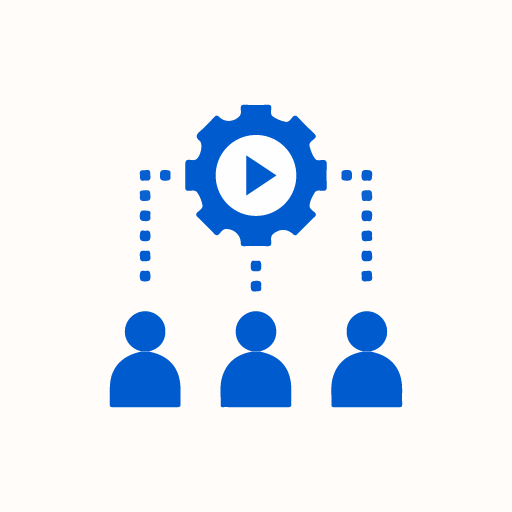How to Create a Digital Asset Management Strategy that Works
29 January 2024
How to Create a Digital Asset Management Strategy that Works
Introduction
The 2023 State of Digital Asset Management report by Brandfolder + Demand Metric found that 77% of study participants were satisfied with their digital asset management (DAM) solution when deployment was completed quickly. However, in the rush to join this satisfied majority, many companies find themselves adrift in a sea of digital chaos.
Picture a company drowning in its own digital creations. Valuable assets are being lost in a haze of disorganization, resulting in missed opportunities, misuse, and drained resources. The decision to adopt a digital asset management system ignites hope across the organization. Still, eagerness for swift deployment often clashes with reality. The pursuit of rapid implementation and excessive features can overshadow the genuine needs of users, resulting in low adoption rates and a disappointing return on investment.
Successfully navigating this scenario hinges on a focused DAM strategy. By prioritizing user needs, organizations can plot a course towards a DAM solution that not only achieves swift adoption but also ensures a clear return on investment and a scalable future. Let’s explore how to set these priorities and approach your DAM initiative with confidence.
Why is a digital asset management strategy needed?
A DAM strategy is a guiding light, providing a path to meaningful outcomes. It ensures your energy, resources, and time are focused where they truly matter, preventing wasteful detours that could jeopardize stakeholder support and trust.
Digital files—images, audio, videos, graphics, presentations, documents, and more—are like any other form of data. They can be assets, an annoyance, and or even a liability to your organization. As assets, they are resources that hold enduring value. Yet, it’s not just the files themselves, but also the accompanying metadata that gives them purpose. Think of a photo: knowing who is in it, and where and how you can use it is just as important as having the jpg. This fusion of media, metadata, and the right to reuse sets them apart as assets, not just files.
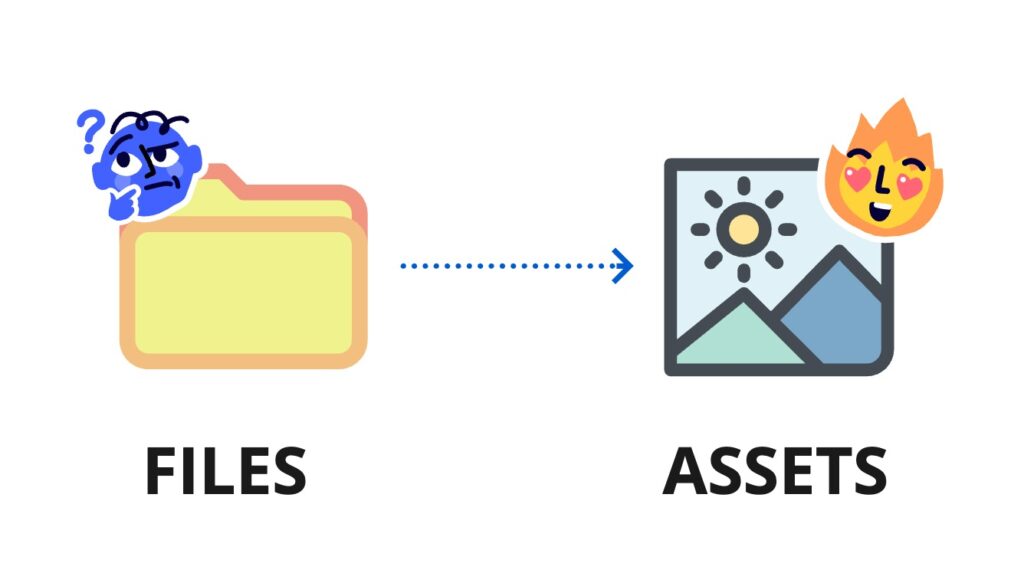
But turning digital files into digital assets requires investment—technology, staffing, processes, policies, governance—the works. This investment should be strategic, focused where it packs the most punch and sets the stage for scalable growth.
So, when does a DAM strategy matter? Anytime you face hurdles in finding, using, or safeguarding digital assets. Think of when:
Your asset collection makes finding files feel like searching for a needle in a haystack.
Multiple departmental DAMS beg for unity under an enterprise DAM software.
Your legacy DAM software no longer keeps up with your evolving needs.
Your current DAM setup needs expansion or optimization.
These scenarios aren’t just inconveniences. They lead to inefficiencies, frustration, misuse, and needless duplication. This is where your DAM strategy comes in. It ensures your energy and resources are channeled into solving real problems, ensuring a meaningful payoff from your investment.
What is a digital asset management strategy?
Strategy is problem-solving. It is how you overcome the obstacles that stand between where you are and what you want to achieve.
Richard Rumelt
A digital asset management strategy is an organization’s planned response to the challenge of needing to organize, secure, and deliver digital assets to the users that need them, now and in the future.
More specifically, a digital asset management strategy identifies priorities so you can put resources where they will have the most impact. To state the obvious — you can’t do everything at once. A DAM strategy will tell you where to start, where to go next, what to put on the back burner, and what success looks like. Good strategy is as much about what you won’t do as it is about what you will do.
Our approach? Put users first. A user-centered DAM strategy centers on understanding and addressing user needs, and developing a cohesive response that will effectively address those needs.
Ready to dive in? Let’s develop a strategy that responds to your organization’s unique needs and goals.
What does a digital asset management strategy consist of?
Our approach to DAM strategy is rooted in the framework developed by Richard Rumelt and described in his book, Good Strategy Bad Strategy: The Difference and Why It Matters. Rumelt emphasizes that good strategy is simple. It consists of a diagnosis of the challenge that you are responding to, a guiding policy that describes the approach you will take to responding to the challenge, and a set of coherent actions designed to carry out the guiding policy.
We can adapt this framework to data and digital asset management this way:
- The diagnosis is the identification of the problem an organization has with digital asset management, use, and delivery. Specifically, the diagnosis details what impact this issue is having on people (e.g., users waste time looking for assets, assets are misused)
- The guiding policy is that a use-case centered approach will be taken to solve these challenges.
- The coherent actions are the key areas of investment that you will make to solve the challenge and meet users’ needs.

Using this framework, a user-centered digital asset management strategy can be structured as follows:
- Challenge: A clear identification of the problem that the DAM strategy is responding to. The goal of this statement is to align stakeholders on what you are solving for, and to guide prioritization.
- Use cases & data: Prioritized and sequenced high-level digital asset use cases that identify practical applications of asset use, as well as the assets and metadata that are needed to enable those use cases.
- Initiatives & actions: A summary of key investments and actions that will enable the guiding use cases, including: data quality remediation efforts, technology initiatives, and enablers such as governance, process, people and continuous improvement.
We have developed a DAM Strategy Canvas to help you iteratively capture your ideas along the way. Throughout this guide, we will point out where and when to populate the different sections of the canvas.
Steps to developing a digital asset management strategy
We suggest building your DAM strategy in this order:
- Agree on the problem: Align stakeholders around the key challenge, and ensure alignment with the broader organizational strategy.
- Assess user needs: Learn from priority users about their specific needs and requirements.
- Develop use cases and data requirements: Document priority use cases that will drive the DAM strategy. Identify and document the associated data needs for each use case.
- Conduct a data quality, technical, and operational gap analysis: Assess the data, technology, and operational landscape and determine what investments will be needed for success.
- Prioritize key initiatives and actions: Identify and prioritize initiatives based on an understanding of data quality, dependencies, and technology and operational resource needs.
- Define success: Identify the key metrics that will indicate that you have successfully solved the problem
- Communicate, execute, and iterate: Ensure transparency, foster buy-in, support change management, and be ready to adapt.
Let’s dive into each of these steps.
1. Agree on the problem
Aligning stakeholders around the identified digital asset management challenge is a crucial first step in developing a successful DAM strategy. Gaining clarity on the problem to be solved will help focus subsequent efforts on a clear objective. Articulating the problem will also aid in presenting the business case for proposed investments. The problem should be significant enough to necessitate a strategic response.
To start, explore the need for an improved DAM solution within your organization. Engage stakeholders from different departments and levels of seniority to gather diverse perspectives and insights. These stakeholders can articulate how digital asset problems impact the business and provide insights into opportunities, resources, and constraints, especially budgetary concerns.
💡Tip!
Stakeholder Interviews 101 by the Nielsen Norman Group offer excellent tips on planning and conducting this type of interview.
By examining the issue from various perspectives, you can identify common themes and begin to coalesce around a top concern.
Be careful at this stage to focus only on the problem, not potential solutions. And don’t bake solutions into problem statements. For example: “We need DAM software” is a solution, not a problem. “It is taking people days to find the right asset, causing us delays to campaign timelines” is a problem.
As you narrow down the problem, it can be useful to articulate it using a Situation-Complication-Question framework. First, describe the situation — what is the problematic thing happening? Next, add in the complication — why is this happening, and what are the stakes? Finally, frame the challenge as a question — how might we resolve the situation given the complication?
Once key stakeholders align on the diagnosis and framing of the problem, populate the Challenge section of your DAM Strategy Canvas.
2. Assess users’ needs
The next step in building your digital asset management strategy is to identify and prioritize key digital asset use cases, and the data that are required for those uses to be successful.
Start by taking a deep dive into exploring users’ needs. First, identify and prioritize the users and stakeholders who rely on digital assets and are most affected by the problem you are working to solve. Seek to understand the situation from their point of view. Conducting user interviews allows you to empathize with users and gather insights on their challenges, while helping create further alignment and fostering buy-in.
Prepare an interview discussion guide that lists key topics you will want to learn about from your interviewees, including the use cases they need digital assets for, the types of assets they need, and the information accompanying the assets that are important.
💡Tip!
While you are talking to users, press for some hard numbers on how much time they spend searching for assets or money they are spending recreating and managing digital assets now. This qualitative information can be used to measure ROI against later and demonstrate the impact of the digital asset management solution.
Record and take notes during user interviews to help develop use cases and requirements in the next step.
3. Prioritize use cases and data requirements
Once you have completed user interviews, synthesize the results to look for recurring pain points, common requests, and top priorities. The results of this exercise will help you identify:
- The priority use cases your digital asset management program should serve
- What digital assets are most important to users
- What metadata are most important for search, browse, and use of digital assets
One way to synthesize your findings is to do an affinity mapping, or clustering, exercise. First, highlight any key findings from notes or transcripts. Next, put these highlights on sticky notes (one finding per note) then add these to a physical or virtual whiteboard. Reorganize notes into clusters around common themes, then label the cluster of sticky notes.
In the example above, each color note represents a different user. In the Use Cases box, we have one cluster about quickly finding product images for marketing campaigns, and another about 3D asset versions. The Data Needs box shows one cluster shows where multiple people have said that rights/usage information is important to them, and another where two people indicate that the product ID or SKU is important. When multiple people ask for the same thing, these are candidates for prioritization.
Be sure to include sections of your affinity map for:
- Use cases
- Data needs (including required files, formats, and metadata)
- Technology and functional needs
Use Cases
Your next goal is to identify the highest priority digital asset use cases that the strategy will focus on. Use cases should be high level, simple, and clear. They should identify who the user is, what they want to do with digital assets, and why. As a bonus, include the frequency of use.
Here is a simple example use case: “Marketers need quick access to brand assets every day in order to develop campaigns about our products.” This statement is concise, it identifies the user, it describes what they need assets for, and how frequently. Your use cases can be more detailed than this, but don’t make them overly complex.
Once you have sketched out the key use cases, sequence them according to priority. This will be the order in which you will start to build your DAM solution.
The key is to remember — and to clearly communicate to all stakeholders — that these foundational use cases are more than solutions for specific user groups. You will build capabilities for these use cases in a way that also addresses the needs of many other users, both current and future.
Prioritizing use cases requires weighing several factors around need, impact, and feasibility. An impact-effort mapping exercise can be helpful at this point. Start by creating a two by two grid where one axis is Impact and the other is Effort. Plot your use cases on the grid by considering them relative to one another.
The use cases that land in the High Impact / Low Effort quadrant are probably your first priorities, followed by High Impact / High Effort. Those that fall into the Low Impact area of the grid should not be part of your digital asset management strategy at this stage.
Once you have agreement on the top use cases and their priority order, populate the Use Cases section of your DAM Strategy Canvas.
Data Requirements
Once you have settled on the priority use cases, determine the corresponding data (asset and metadata) needs. We suggest approaching this by drafting a series of questions that users will be asking about digital assets when they try to find and use them.
For our product marketing use case above, the user may be asking:
- What images of a specific product do we have?
- In what territories can I use each product image?
- How should I credit the image?
Your goal is to ensure that your DAM solution can easily answer users’ top questions, so it’s important to clearly identify what those questions are. Talk to your users again if needed.
Once you have the questions listed, turn these into data needs. Consider the types of unique data assets needed to fulfill the priority use cases. Then, determine what metadata you will need to answer those questions.
Returning to the marketing use case, we recognize that marketers require product images (asset type), and for each image, they need to know in what territories they can use it (metadata), and how to attribute the image (metadata).
Once you have clarified the main data points and needs, populate the Data section of your DAM Strategy Canvas. We realize that this may end up being a level of detail more than you can fit on the canvas. Feel free to create a supplementary sheet to keep track of everything.
At the end of this step you should have a good sense of who needs digital assets, for what purposes, which types of assets, and what are the most important metadata. Next you will figure out how to deliver on those priorities.
4. Conduct a data, technical, and operational gap analysis
At this point you have identified what your digital asset management strategy needs to solve for – the challenge, the use cases, and the data needs. Next, determine the key initiatives and actions needed to deliver results. This will require taking a close look at the current state of your data, as well as your existing digital assets, asset technology and operations, and flagging any gaps between where you are today, and where you want to go.
💡Tip!
Learn more about AVP’s Technical And Operational Model for DAM Success to help with your assessment!
As you work through these technology and operations topics, jot down ideas of improvements you might need to make in each area to solve the key challenge. You will later go through an exercise to prioritize and turn these into key actions.
Technology
During user and stakeholder interviews, you probably heard a lot about the technological capabilities and functionality that people want. Now that you have these inputs, take time to draft a set of key requirements for digital asset management technology. Don’t get too lost in the details at this stage; concentrate on the real deal breakers. Identify what functionality is absolutely necessary for the success of this DAM strategy.
Next, take a look at your current technology ecosystem. Does it support this functionality today? If yes, then congratulations! Technology is not going to be one of your key initiatives.
If it does not, then you are likely looking at a technology investment, most likely in a digital asset management software, and possibly other technologies. Consider the entire scope of the use cases, and the technical environment to determine whether things like storage solutions, and/or integrations with downstream or upstream systems will be needed. It is easy to get into the mindset that everything is equally important when thinking about technology. Focus on the must-haves, rather than the nice-to-haves.
Governance
Governance is the combination of decision-making, issue resolution, roles, responsibilities, policies, and standards that work to ensure ongoing data quality, protect the organization, and manage risk. When evaluating this area, think about:
- Roles & responsibilities – What roles will be needed for ongoing digital asset management, including product or system management, asset and metadata creation, quality assurance, and user support? Do they exist today?
- Standards – Do guidelines exist that tell people how to create quality assets and metadata that align with priority use cases? Do taxonomies exist that structure and organize assets? Do you keep them up to date?
- Policies – What rules are in place to guide security, permissions, usage, and retention? Are they effective? Do you keep them up to date?
After assessing these elements, think about the changes you might need to make to achieve your goals.
Data quality
Now that you understand users’ expectations for digital assets, metadata and overall quality, what needs to happen to bring existing digital assets in line with those expectations? Are the priority asset types readily available to the priority users? Are you consistently capturing and applying key metadata? Do you have a taxonomy that structures assets so that they are easy to search for, find, and interpret?
If during user interviews you heard that people are struggling to find, understand, and use digital assets, the answer to these questions is probably – NO. At this point your main goal is to identify where the main issues and needs are for those priority use cases. Consider data or asset creation (where they don’t exist), remediation (where cleanup is needed), and/or migration (when consolidation is needed).
Process
This area includes digital asset management workflows, business processes, documentation, and training, all oriented around fulfilling the priority use cases and ensuring ongoing data quality. When exploring the the current state and needs around process, consider:
- What digital asset workflows exist today? How well are they followed?
- How are new staff trained in digital asset creation and usage?
- What documentation exists for people to refer to when they have a question? How easy is it to access? Does everyone know where to find it?
- How do users submit questions, report bugs, and get troubleshooting help?
Note anything that feels missing or insufficient here.
People
Digital assets don’t make, organize, describe, and quality assure themselves (AI can increasingly help with some of these tasks, but humans will still need to be in the loop 😉). What skills, areas of expertise, and positions are needed to fulfill the roles and responsibilities outlined in your governance review? Think about the DAM-specific staffing (DAM managers, taxonomists, etc) as well as partners in your technology organization.
Consider your short-term and long-term needs. Do you need additional expertise and capacity to implement your DAM strategy? Are those people available internally, or will external resources be needed? This may be another area of potential investment to flag.
Continuous Improvement
Continuous improvement covers a range of topics including: goal setting and roadmapping, measurement and tracking, collaboration and ways of working, and change management. To evaluate this area, ask:
- Do we have a mechanism for creating goals and milestones for the DAM program?
- Does our team have a way of working (e.g., Agile) that will help us reach our goals while remaining flexible?
- Do we consistently track progress and measure success toward our goals?
- How do we approach change management, especially considering that we are embarking on a major change initiative?
5. Prioritize Key Initiatives and Actions
The gap analysis will reveal numerous strengths and shortcomings. At this stage, another prioritization effort will need to take place to answer the question: of all of the shortcomings we have identified, which can we solve that will create value and deliver impact for the priority use cases?
Remember, the goal is to use the resources you have on the highest priority items first.
Impact/effort exercises also work well here to help scope, shape, and sequence work, which make it easier to plan and execute when the time comes to implement.
As a prioritization check, it can be helpful to map the use cases to the initiatives. Does the proposed initiative address the highest priority use cases? Does it address multiple use cases? Be cautious of proposing actions that won’t directly impact the use cases and the primary objective that the DAM strategy is addressing.
Once you have identified priority actions that consider all the key areas explored during the gap analysis exercise, write these as objectives accompanied by measurable success metrics. For example, if you noted that your organization is lacking a digital asset management system that is capable of fulfilling priority use cases, an objective could be: “Procure, implement, and launch a new DAM system,” with the result being: “DAM system is launched to beta testers by Q3 2024.” If a large data remediation effort is needed, the objective could specify the metadata attributes that need improvement, with a result that reads something like: “Implement a new metadata standard, achieving 98% compliance within six months.”
Finally, document the Key Actions and Results on your DAM Strategy Canvas.
6. Define success
If you have followed along this far, your DAM strategy canvas is nearly complete, with the exception of one section: Success Criteria!
Reflect on what success really looks like. If you were to take all of the outlined steps and invest in all of the initiatives, how would you know if you have gotten it right? What would success look like if you solved the problem?
Jot down and refine your ideas until it feels like you have right metrics. These indicators of success will become the KPIs for your overall DAM strategy.
Complete the Success Criteria section of your DAM Strategy Canvas, then review the entire thing to make sure everything you’ve included is going to help you reach those success metrics.

7. Communicate, execute, and iterate
If you have made it to this point, congratulations — you have a digital asset management strategy! If you have done this correctly, you should have diagnosed the challenge, identified a set of guiding use cases, identified the assets and metadata that are important to those use cases, and proposed a series of initiatives and actions that will allow you to stay focused on reaching the success criteria. You can now create a roadmap to sequence actions and put this strategy to work!
This DAM strategy will help you avoid making ill-fated attempts to solve for everyone and everything all at once. We have seen this approach fail countless times, resulting in half-baked solutions that leave users frustrated, losing their trust along the way.
A better way is to take an iterative approach, creating value, and continuously and iteratively building out capabilities to do more. Do a few things really well, then scale.
This is where communication and execution of your strategy becomes critical. Sharing how you developed the strategy, how you established priorities, and how you will iteratively build and execute to develop capabilities and solve for priority use cases will help you avoid the dreaded trap of pressure to do more from stakeholders. Avoiding scope creep as much as possible is critical to a successful DAM strategy.
Nevertheless, remain flexible. Over time, as organizational strategies and priorities change, you can revisit and re-prioritize the use cases and data needs in response. Your DAM Strategy will become a living document, continually being tweaked and refined as you solve for the issues that were frustrating your organization when you started.
Along the way, continue the process of engaging stakeholders for input and feedback, communicating the strategy and its evolution. Maintain transparency and clarity, and demonstrate your successes as you go.
Transform your DAM experience
Development of a digital asset management strategy may be done quickly — in an intensive workshop held over the course of a few hours. Or, it may be built incrementally over a few weeks or months.
In either case, it can be helpful to have an expert guide support the process.
At AVP, we specialize in helping organizations develop and implement DAM strategies that deliver impact. Our goal is to ensure that you end up with a plan that keeps you on track to reach your vision, that provides direction for the use of limited resources, and that ensures your users will be delighted.
We offer a few ways to jumpstart your digital asset management strategy:
- Schedule a 1 hour consulting call where we will talk through your DAM strategy planning, or review the work you have done so far
- Let us facilitate a strategy workshop for your team, and coach you through the process of creating your DAM strategy
- Engage with us in a full service DAM strategy consultation. We will facilitate stakeholder meetings, interview users, suggest key initiatives, document your complete DAM strategy, create your roadmap, develop communication plans, and present to stakeholders.
AVP’s Operational Model for DAM Success
1 January 2024
Running a DAM System? Here’s an Operational Model for Success
Choosing digital asset management (DAM) software is the easiest part—onboarding users, integrating it into your existing tech stack, and weaving it into the ways of your company is when the real difficulties can begin. But those challenges are easier managed, and the value of the DAM system easier realized, if you employ an operational model as part of your DAM implementation.
We’ve developed this approach from years of experience, working with highly varied organizations, to correctly implement and scale DAM systems. Our operational model shared here is a supported, systematic approach that isn’t included with your digital asset management software.
A DAM operational model is a method and mindset for managing and mastering your DAM system that utilizes a blended approach of program, product, and service management.
Think of your operational model as the literal roadmap toward a complete DAM implementation, long-term ease of asset management, and delivery of value to your organization. To achieve lasting success—and what we will lay out in full detail in this piece—your DAM operational model should account for the following components:
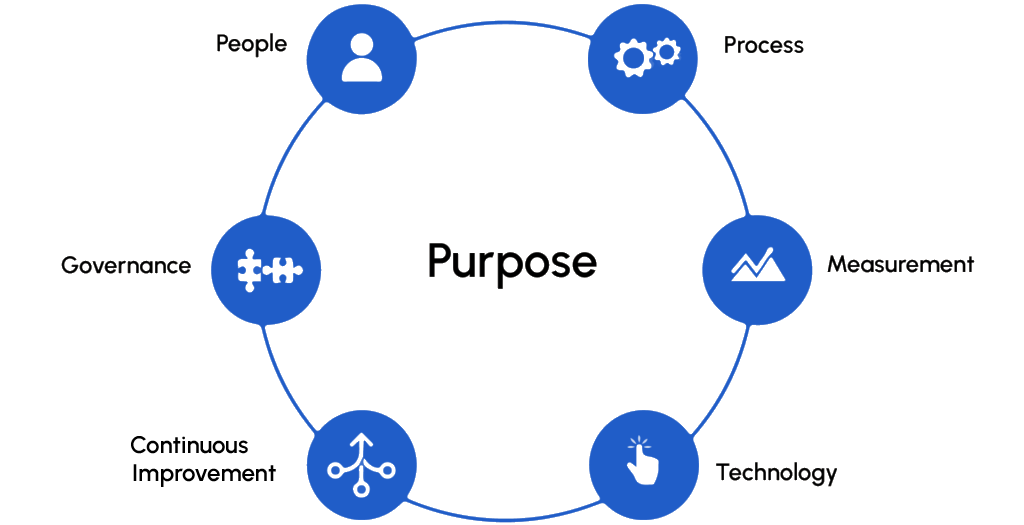
DAM implementation What does implementing these components look like in a business that has many of the same concerns and goals that you have? We’ll spell out exactly how to navigate these seven components of a DAM operational model and explain how they both build upon and interact with one another.

Table of Contents
- Purpose: Defining the value of your DAM system
- People: The power behind the DAM’s success
- Governance: Critical for integrity and quality
- Technology: The DAM software
- Process: Scale and integrate the DAM system
- Measurement: The key to continual DAM improvement
- Continuous Improvement: Delivering Value Over Time
- It’s Time for Some DAM Success
Purpose: Defining the value of your DAM system
Everything begins with a purpose, including enterprise technology initiatives like DAM implementation. So what’s the purpose of your DAM system?
Most likely, its primary purpose is to give you a better handle on your brand assets. But dig a bit deeper and think about the larger problem or opportunity your DAM serves, and the value that it can add to your organization. There are a few key results many managers look for when adopting a DAM system: saved time and money, reduced risks, and improved new value creation.
Here’s how your DAM system achieves those goals:
People: The power behind the DAM’s success
The purpose of your DAM system is likely tied to both the needs of your people and the pain points of their roles. The team members a DAM serves usually fall into the following user groups:
It’s important to consider and connect each of these user groups in the DAM operational model. If any group isn’t on board, the whole DAM implementation can lose effectiveness, suffer in quality, and ultimately prevent widespread adoption. Delivering value to these users should always be a top priority for DAM system decision-making.
Conducting exploratory work with each user group sets a strong foundation for implementation and ongoing operations. Integrating and aligning the people in your organization who manage and use the DAM system to the purpose is the second step in the operating system we recommend.
Governance: Critical for integrity and quality
Proper governance of your DAM system can enable long-term effectiveness and sustainability. How so? The Governance portion of your DAM operational model includes your policies and standards that ensure data quality, create an effective user experience, and mitigate risks. Essentially, it’s a systematic way to maintain the integrity of your DAM system.
There are five main components of DAM governance:
1. Policies
Policies help maintain system health. You should outline your system policies into at least a few categories:
- Collection policies: What assets are and aren’t in scope for the DAM? What formats and variations are accepted? What metadata is required upon submission?
- Curation policies: Are all assets given equal treatment in terms of processing and metadata? What metadata is required prior to making assets accessible to end users?
- Lifecycle management policy: How long are assets retained in the DAM system? What happens to the asset after it’s removed from the system?
2. Standards
Standards assist the system’s hygiene and data quality. It’s critical to have standards defined and in place as you implement and operate your DAM system, but it is equally as important to define how to handle changes and updates that are necessary over time.
Consider developing local standards and ongoing review processes for:
- Metadata: What fields are used and how should they be populated? Do different assets use different fields?
- Taxonomy: What terms are used to describe the assets? How do these terms enable navigation through the DAM through search and browse features? How does the taxonomy in the DAM align with enterprise taxonomy?
- Classification and Categorization: This is a subset of taxonomy, but a distinct question: How do you categorize and classify assets so that users can easily understand what is available in the system? How are assets grouped for easy access and proper selection for the use case they are needed for?
3. Permissions, Rights, and Security
- Permissions: Who has access to the system? How is access granted? What functionality does each user group have access to? What assets can each user access in the system? What can they do with them?
- Rights: What rights information is tracked in the system? What are the different levels of access rights for various user groups? What data fields are secured to maintain asset integrity? How do you establish rights to a licensed asset?
- Security: What enterprise security policies and systems govern access to your DAM system?
4. Roles and Responsibilities
The user groups we broke out earlier in the people section all should have very clear parameters. It’s critical that all continuous functions of the DAM system are monitored and supported by a specific role function. Therefore, you need highly detailed, example-based role descriptions that come with a set of standard processes, as well.
Consider the following:
- Who is/are the primary business owner(s) who has the authority to make strategic decisions, guide DAM administrators, and continually align the DAM system to business objectives?
- Who are the domain stewards responsible for tactical steering, decision-making, and planning to enable strategy for different functional, content, or business areas served by the DAM system?
- How are the responsibilities for the day-to-day operations of the DAM system defined? If multiple people, how are the roles divided?
- How are responsibilities for asset ingest, organization, tagging, and publication delineated between content contributors and DAM administrators?
You may opt to divide responsibilities across multiple teams or keep DAM system resources together. However you approach assigning them, make sure the responsibilities are clear.
5. Issue & Change Management
The final component of governance is establishing a protocol for issue tracking and resolution. This should involve the creation of mechanisms and tools your teams can use to identify and prioritize issues, as well as creating pathways that resolve the issue.
Protocols should also be in place for change management. A DAM system is constantly changing, growing, and scaling. How is that process managed? How are milestones planned, tracked, and executed? When users report problems and make requests, how is their feedback gathered, ranked, fixed, and reported on? How are new features validated? How frequently are new features released, and how are they communicated to users?
Technology: The DAM software
Let’s revisit the purpose we started with. From your purpose, you can envision what success should look like and what the users need in order to succeed. You also understand how the use of a DAM system aligns with or supports those goals.
What you don’t know is exactly how your DAM system should function to deliver on those goals. This is where the technology part of the DAM operational model comes in. Configure your DAM system such that it fulfills your purpose, the reason you took on a DAM in the first place.
How you use the technology entirely depends on your business objectives, users, use cases, and the value you want the system to deliver.
Configuring Your System
Once you have your base system, it’s time to configure it for impact. Again, your purpose and usage scenarios for the people who will be using the DAM should drive configuration. Here are seven steps to help you configure your system:
When you are starting a new implementation, consider which features are most important to your purpose and users, and roll those out incrementally. Start your configuration with the highest value and biggest impact features and functionality. Then, as you build on more advanced features such as workflow automation and AI enrichment, take a moment to go back to your purpose and people to ensure implementing these features will create value and impact.
Integrating Your System
Your DAM system shouldn’t be an island—it will be most successful when connected to other business systems that use and/or deliver your managed assets. But don’t overdo it; integrations can be hard to pull off and should be reserved for when they have the potential to create the most impact.
For every integration, consider:
Remember: whatever integrations you do apply, make sure they are aligned with the governance standards you established earlier.
DAM System | Tech Checklist
- analytics
- asset display & interaction
- asset management
- collaboration & personalization
- delivery
- export / exit strategy
- ingest
- integrations
- localization
- metadata / description
- asset organization
- preservation
- search & browse
- security
- taxonomy
- workflow
Process: Scale and integrate the DAM system
Along with governance, which sets boundaries and guidelines for your DAM system, you must also establish and document processes as part of your operational model. Processes can help establish trust and a sense of consistency when working with your DAM system.
Like everything else, developing your process goes back to purpose and people—usage scenarios will become workflows configured into the system. You can then create documentation that will help enable your users to fulfill them effectively.
When Should You Develop Processes?
We recommend developing a DAM process for all of the following areas to help your users correctly contribute to and utilize the system:
- Intake and ingest
- Work-in-progress content development
- Review and approval
- Asset organization
- Asset description/terminology/tagging
- Asset delivery and quality assurance
What Makes a Successful Process?
Successful processes should be:
- User-centered and easy to use
- Clear and simple
- Able to accommodate reasonable exceptions
- Well-known among your employees
- Easily accessible when needed
- Communicated in such a way that the user understands the downstream impact of their actions in the system.
Note: Many DAM systems already have workflow features that can help you automate processes. But you still have to make the key decisions to configure what the steps are, and who the players are at each stage.
Beyond processes that describe how to use the system, don’t forget processes that are about the system. For example: how are the latest updates communicated, by whom, and at what frequency? Don’t forget, your DAM system needs marketing too.
“With people in place, roles and responsibilities defined, and your DAM system configured, process becomes very important to adoption. quality and trust.”
Measurement: The key to continual DAM improvement
Those goals that are tethered to your purpose should be tracked and measured–that’s the only way you can truly know if your DAM system is delivering the expected impact. That’s why establishing key performance indicators (KPIs) and/or objectives and key results (OKRs) that are tied to ROl benchmarks as part of your DAM operational model can help you stay informed about your success.
How to Determine Baseline Measurements
Determining the ROl around certain metrics, like time savings, requires you to know the baseline of that metric. Using the cost savings example: how much time did users spend looking for an asset before your organization implemented the DAM system?
Survey your users before implementing your DAM system to understand your typical baseline measurements. Then, you can track improvements with that baseline in mind.
5 Measurements You Should Track
There are plenty of metrics you can track, but which ones should you track? This greatly depends on who you will be reporting to, and what they want to know. The metrics that interest an executive sponsor (increased business value) are likely different from those middle managers care about (increased efficiency and productivity amongst their teams). Establish KPIs according to the outcomes expected by each key stakeholder.
In addition to tracking ROl according to your KPls for stakeholders, DAM managers will want to ensure the system is performing well as it scales, the right people are using the DAM system, users are finding what they need, and time to delivery is increasing. Here are five metrics that we suggest keeping track of.
System capacity & health: Monitor the footprint of the infrastructure to understand what scale it can support. This may involve measuring:
- Storage used
- Number of assets
- Assets uploaded during set time periods
- Concurrent users
Content: To help you know how to organize and describe assets so they can be easily found and used, track:
- Most commonly used search terms
- Most commonly used browse terms
- Classification performance
Asset performance: Understanding what kind of content is performing well (which may guide future content creation). You may look at:
- Assets viewed
- Assets downloaded
- Assets shared/saved
- Asset usage purpose
- Where people have used an asset previously
Users: Which type of people are using your system (and how many)? You likely want to understand usage at both department and business unit levels. You might start by looking at:
- Number of users
- Logins per user
- Downloads per user
Requests: These show where people are getting stuck and/or need additional help. Tracking requests may reveal how you can help users self-serve more easily. Measure:
- Reference requests (difficulty finding assets)
- Support requests and tickets (bugs and other technical issues)
Ensure that the outcome of tracking and reporting isn’t just analytics theater or leading to analysis paralysis – your governance structure should provide mechanisms to derive insights from measurement, make decisions, and take action.
Qualitative Measurement
In addition to quantitative measurement, you should also routinely gather qualitative feedback from users. Conduct regular user testing sessions to test that the system is meeting users’ expectations. Implement mechanisms that deliver regular feedback that you can use to gather specific and actionable feedback.
Continuous Improvement: Delivering Value Over Time
Continuous improvement involves setting clear goals for the DAM system to enhance ROI, consistently tracking and measuring progress, and responding proactively to measurements. It’s also about adapting to change over time and being able to pivot when it’s necessary. If your DAM operation isn’t evolving to keep up with changes in organizational strategy, advancement of technologies, new types of assets, evolving user needs and expectations, and organizational policies and workflows, its health and value will decline over time.
How effectively can you align stakeholders and team members to ensure the DAM system consistently delivers value as defined by its purpose?
Are you conducting regular evaluations and updates to maintain and enhance the operation, meeting new challenges and seizing opportunities?
For continuous improvement:
It’s Time for Some DAM Success
If you read this operational guide fully, you are well on your way to improving your DAM system. Keep this in mind: reading and learning are always easier than execution. Bookmark this page, come back often through your journey, and keep returning to your purpose when you feel overwhelmed.
We recommend evaluating your DAM system’s operational health on a cyclical basis. The DAM will continually be asked to solve new problems, support new users and new types of assets. The DAM Operational Model framework that we’ve shared will help ensure you have a continuous process of DAM operational success.
We’ve helped a lot of big companies successfully integrate DAM systems. Often, we act as a guide along the road of uncertainty, helping to support a positive experience for your teams.
DAM Health Scorecard
1 January 2024
Get Your DAM Budget: Slide Deck Template
28 December 2023
Get your DAM budget: How to get your boss on board with your Digital Asset Management strategy
28 December 2023
Get your DAM budget: How to get your boss on board with your Digital Asset Management strategy
You, like so many other DAM managers out there, are a team of one or few. Every week you’re working hard to add more assets to your digital asset management (DAM) system, improve data quality, and help users, while also fixing another problem, onboarding new users, running another audit, or starting another project. There is also a laundry list of improvements you want to make if you can ever find the time. How can you build a digital asset management business case to support these efforts? Maybe you are looking for support with these common scenarios:
- You’ve outgrown your current solution (Dropbox, Box, Google Drive, hard drives, etc)
- Your DAM has launched, but it needs more resources to scale
- Your legacy DAM is no longer meeting the requirements of the business or it can’t scale.
When you ask for resources to help solve the problem, it’s crickets. The budget is just not there.
You should know you’re not alone. It can be notoriously difficult for DAM managers to get the budget they’re asking for because the ROI is not always clear (or easy to calculate).
We’re here to help. We can’t give you a magic wand to conjure up a budget that doesn’t exist. But we can certainly help you maximize your chances of getting the “yes” for that next budget pitch you’re making to your leaders.
Trust us: the right planning and execution can turn your frustration into feelings of optimism and empowerment as you convince budget-holders that DAM is worth the ongoing investment.
Here we go.
Understand Your Audience and Stakeholders
As with most projects, everything starts with trying to understand the people (stakeholders) you’re pitching to. Remember, DAM doesn’t exist in a vacuum. It is a service that delivers value to the organization and furthers its strategic aims. Therefore, to make a compelling case you need to look out, not in. Be able to tell leaders what’s in it for them, while empathizing with the prioritization decisions they have to make.
Start by asking the very basic question: how does the DAM advance my stakeholders’ goals (and what are those things)?
This simple exercise is going to help you consider how the DAM brings value to the people you’re pitching to. Remember, you’re trying to inspire and motivate leaders to support your vision for DAM. To do it, start by understanding theirs.
Look to existing resources to understand the priorities of your organization, division, and/or business unit.
- Strategic plans: What are the competitive goals and objectives your organization is setting? What are they committing to achieve?
- Recent communications: Have there been internal or external communications published that provide information on strategic directions for the business?
- People: Can you speak with your leaders, or if they aren’t available, the people who report to them? Try to learn what decisions they are weighing, where they are focusing their energy and resources, and their current priorities (or even better, goals or KPIs)
Don’t assume you already know these answers. Goals, priorities, concerns, and stock prices change frequently. What was true last week may not be this week. Taking the time to learn from relevant and timely sources can help you identify opportunities to show value against what’s happening in the company today, and where it’s going.
Once you’ve gone through this exercise, pick the top two or three issues or goals that DAM can help to enable. We’ll focus on those moving forward.
Enable Strategic Goals Through Digital Asset Management
Now that you have your top two or three strategic goals, you need to identify just how exactly the DAM is going to enable those.
It’s not always an easy 1:1 relationship when it comes to how the DAM provides value to a business. You may need to do some thinking here, but here’s an example to help you get your head around it:
Example 1
By looking at the strategic plan, you’ve identified the business is really pushing to speed up time to market for new products. You know the company is starting to use 3D models as part of the design and production of these products, but the workflows for these creative assets are less than optimal. Different teams store assets in different locations, and people spend a lot of time looking for specific assets. Then once they find them, they can’t be sure they’ve found the right version. Simply by centralizing those 3D assets in the DAM, you can immediately save time and money on those processes and help advance that push to speed time to market.
Example 2
Another example is a company’s new data transparency strategy. The organization wants to ensure that both employees and customers understand what data they collect, store, and use. They also want to maintain a clear provenance of data collection and use. Because digital assets are part of the organization’s enterprise data set, the DAM can act as a centralized data hub and source of truth for certain classes of data.
Articulate the value of DAM by aligning with strategic goals
Neither of those examples may apply to your specific situation, but you can see how understanding the strategic goals of your organization can help you tie in DAM to those essential projects.
The key is to empathize with the problem, align your understanding of the goal, and then articulate a solution. Think about using this format to articulate your value proposition pitch:
We know that [goal] is a major priority of [org name], based on [the timely primary resources consulted]. We believe that doing [x, y, z] will help further this goal in these specific ways: [list, items, here]
Identify Digital Asset Management Cost Savings
Just because you’ve figured out how to tie DAM to strategic projects and goals doesn’t mean you’re done building your digital asset management business case!
It’s almost a guarantee that leadership will ask you how your system is saving the company time and money. This question is what trips up a lot of DAM managers—there are so many ways to answer it! Ultimately, you want to go beyond saying “DAM increases productivity” or “DAM reduces content spend.” Instead, go deeper with details on how, and try to quantify wherever possible.
Reducing content spend
Here’s an example for you. One of a creative team’s biggest expenses is the cost of licensing content from a creator or company like Getty Images. Let’s say your organization also shoots a lot of video content. Some of this was expensive-to-produce footage, shot on location in remote areas. During the editing process, we estimate that 80% of footage (b-roll and other cuts) is left unused from a given shoot. That doesn’t mean the footage is bad, it just didn’t make the cut for this video. This content is often forgotten about as the creative team moves on to new projects. It is kept – probably on a hard drive on someone’s desk, along with hundreds of others – because the team knows there is potential value there, but it just contributes to the enormous growing backlog that never seems to get tackled.
The next year, the production team is working on a new edit, and that aerial footage that ended up on the cutting room floor last year would be perfect. Unfortunately, no one remembers it, much less knows where it is. They license similar, although far more generic, footage from a stock provider instead – the same footage they licensed two years ago.
That’s a huge opportunity here for DAM. How much could the company have saved by reusing its own footage instead of re-licensing it? You can easily source that information, and just there you’ve found quantifiable cost savings for the creative team. And as a bonus, you have the opportunity to create higher-quality content that is original and on-brand.
The DAM gives you an entire library of images, b-roll footage, and more your company can use in lieu of purchasing stock footage. And these are assets that are created as part of existing projects, meaning you’re helping to not only save your company money on purchasing content, but maximizing the ROI of existing creative/content spend. These are the types of outcomes that make executives happy, and ones you can demonstrate in your digital asset management business case.
Boost efficiency and time savings
Don’t make the mistake of thinking what is obvious to you is obvious to others. In your digital asset management business case, don’t overlook how much time users save by having a centralized content repository optimized for findability.
Creative teams will tell you that any time they can’t find an asset in the DAM, one of two things happens:
- They recreate an asset from scratch. (See the above section on digital asset management cost savings associated with reducing production and licensing costs.)
- They ask someone where to find it. This triggers a chain of events that often leads to the creative waiting days, sometimes weeks, for an answer from “the person who knows where everything is,” who may be on PTO this week, or just too busy to help.
Remember: make sure whatever integrations you apply are aligned with the governance standards you established earlier.
Once they find the asset they are looking for, it will often have no metadata (including critical rights information) associated. That forces them to turn to the legal team, and the wait gets even longer.
So, it’s not an exaggeration to say the DAM can speed up content creation by a factor of weeks. It can also improve the likelihood that your users will find what they are looking for, rather than settling for something familiar and easy to use (but has been used too many times before).
Get more precise by talking with your creative team to understand how much time they are spending (or would spend if they didn’t have a DAM) on finding assets to use. While you’re at it, find out how often they are successful in finding what they’re looking for, and how often they have to compromise by using a less compelling or overused asset or turn to stock once again.
The cost of inaction
Sometimes the best way to think about a digital asset management business case is not always identifying the benefit of DAM, but calling out the cost of inaction if DAM doesn’t get the investment it needs.
You can go from saying:
“DAM centralizes video assets to make it easier to find and reuse content.”
To something like:
“Reshooting videos next year is going to cost you $10 million, unless you have a DAM to reduce how many reshoots we need.”
Or from saying:
“DAM can help protect restricted assets.”
To something like:
“We have experienced several cases of license violations that have cost us $1 million annually the last two years, and which we are budgeting for in the future. Implementing a DAM with strong permissions and usage metadata can protect our media content and reduce our litigation budget.”
It’s a subtle but different way of thinking about the ROI the DAM provides. Sometimes when you’re dealing with budget holders, it can be easier to loosen the purse strings when they see the problem they’re solving first. Spending $200,000 per year to save millions on video reshoots sounds like a no-brainer, right?
Calculate the ROI of Your Requested DAM Investment
By now we’ve identified the strategic goals that matter to your stakeholders, budget-holders, and leaders. We’ve also decided what measures (cost savings, time savings, etc.) to use in our digital asset management business case, and started to collect some initial data. Now it’s time to gather even more quantifiable data and put it all together to measure or project the ROI of our investment in DAM.
Focus on the strategic priorities
Try to avoid the trap of measuring everything you can think of to maximize the perceived DAM ROI. Instead, stay hyper-focused on the measurements that relate to the strategic priorities you identified at the beginning of this process.
ROI is a pretty simple formula = Return or Benefit / Cost or Investment. Let’s start with the return.
Calculate the benefit
Start by measuring your baselines. What are we doing right now, and how is it performing?
If we’re measuring cost savings, then we need to know what our costs are right now. If our measure is time savings, we need to measure how much time we’re spending on things right now. And if it’s risk mitigation (rights management), how much are we spending on content-related lawsuits today?
The takeaway here is that we can’t calculate the ROI until we understand these baselines.
Now, you may not always have the exact numbers in front of you, but it’s okay to extrapolate a little as long as the multipliers you’re using make sense. Gather as much data as you can, then do some analysis.
For example, you may be able to find out exactly how much the creative team spends on licensing content per campaign. But to find out how much time they spend looking for assets and their allowed usage, you may need to take the average time a few designers spend looking for images, multiply that by how many images are needed on average for a campaign (considering multiple distribution channels as well, so each image has multiple versions), and how many campaigns are run each year.
Now use those baselines to set thoughtful projections on how the DAM will impact them. Set and communicate the goals you have for each measurement so leaders know there is accountability on your end.
Estimate the cost
Next, you will need to have figures on the cost of the investment you want to make to round out the other side of the equation. You will need to have projected what resources you need, and what the associated costs will be.
When you put it all together, you need to be able to demonstrate that the benefits outweigh the costs.
How to Demonstrate Impact and Make the Digital Asset Management Business Case
This is a lot of data you’ve collected. Avoid overloading your audience with information that takes away from the main points you want to make in your pitch.
While each organization is different, often the strongest communication mechanism when addressing leaders and executives is to use a short, streamlined slide deck. You may or may not have the chance to present it. So make sure it can stand alone to get the key messages across at a glance.
Your presentation should clearly describe how the DAM is going to contribute to the organization’s strategic goals. Lead with this so the impact is clear.
More tips for demonstrating impact
- Know your audience: If they like to have all the data in front of them, consider including an executive summary slide first so they get the key message before diving into the data. Include some compelling, on-brand visuals.
- Demonstrate past impact (optional): If you have already achieved success with the DAM, showcase this! What returns have you already realized? Include a quote from someone who has benefited.
- Demonstrate future impact: Show the benchmark data you’ve pulled and how you anticipate improving it through the DAM initiative.
- Be succinct: Slide overload will kill your pitch – 5–10 slides should be your target.
- Show your roadmap: let them see your plan, project milestones, different phases, and how you’re going to track progress
Next, be specific about what you’re asking for:
- Be prepared to answer questions about digital asset management costs. If your ask is for technology, you need to consider DAM license costs and implementation fees. Do some shopping around to get a ballpark figure to use.
- If your ask is for more headcount/resources, you should know what the costs are.
If you aren’t sure about these things, talk to sister organizations – companies in the same industry or of similar size. Ask these community resources what their commitments were/what they spent.
Include what success is going to look like. Answer these questions: How are you putting the new budget to use? What is it going to do for the organization? How are you measuring success? What timeline do you need to achieve those results?
The Power of Storytelling
People love stories. They’re easy to relate to and can be a compelling way to receive information.
As you’re presenting your data to the leadership team, think about how you can turn it into a story that helps you make your digital asset management business case. For example, let’s say you’re asking for additional budget to implement a new workflow module in your DAM. Maybe you showcase the lifecycle of the creative process: walk executives through each step of the process from the perspective of the user, using a specific example that resonates with them. For example, use a common scenario like, “Where can I find the most recent version of our last campaign in Mexico?”
Walk the audience through the challenges that this user faces today, then what their experience will be once it is solved – calling out your data points in compelling visuals along the way – in order to demonstrate exactly where your proposed plan will make an impact on productivity and change the story’s outcome.
You can do this on a single slide! It doesn’t have to be complicated. Just make sure you’re telling a story with your data that will help contextualize the impact of your proposed project.
Getting Budget for Your DAM
Securing a budget is not easy. But the steps outlined above are going to help you be well-prepared for the pitch. Just be sure you factor in your company’s budget cycles. You want to be prepared ahead of time so you’re ready when the time comes, rather than scrambling at the last minute to get your pitch in.
By the time you’ve gone through this process, you should have:
- Identified strategic priorities for the business that are enabled by DAM
- Documented cost, time, and resource savings generally provided by the DAM to further those strategic aims
- Measured baselines, set benchmarks, and identified goals for success
- Built and (possibly) delivered a pitch deck tailored to the needs of your budget-holders specifically
For help pulling this all together, click here to download a slide deck template. It will help you document the details you’ll want to include in your pitch, calculate some of the figures that you will want to highlight, and pull together your story. This free tool was developed collaboratively by Tenovos and AVP.
With the new budget you’re going to win, you can start to deliver on the evolving requirements of the business and your stakeholders without the late nights and stress that come with being understaffed, or saddled with the wrong tool for the job. There’s hope – it just takes the right planning and execution.
This piece was written in collaboration with Tenovos. Tenovos is a data-first digital asset management platform, intuitively designed to empower brands to streamline and automate the traditional complexities of creating and publishing global content.
Related AVP guide: “DAM Operational Model“
